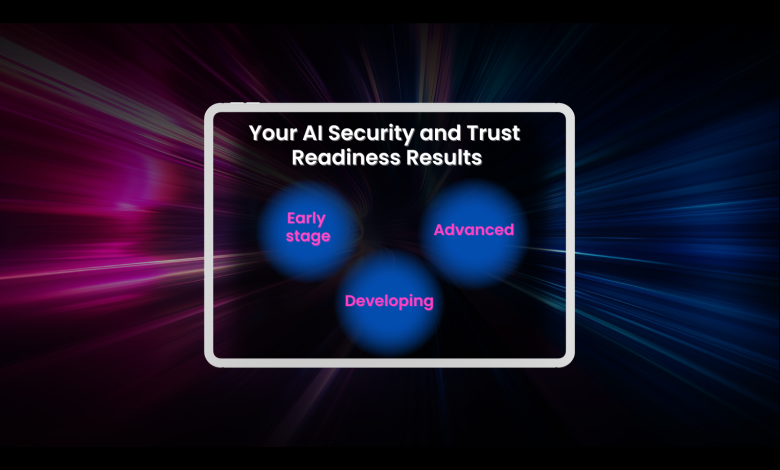Measure Your AI Risk Preparedness with This Interactive Self-Assessment Tool

Effectively managing these risks requires human expertise and strategic oversight. That’s where the AI Risk Readiness Self-Assessment Tool comes in — helping your organization evaluate the security and compliance preparedness of your AI models and systems.
What Is the AI Risk Readiness Self-Assessment Tool?
The AI Risk Readiness Tool is an interactive assessment designed to help organizations evaluate their AI-related risks. By answering nine key questions about your AI assets, development stage, security measures, and compliance needs, the tool generates tailored risk management strategies to mitigate AI safety issues and vulnerability, based on your specific threat model and business needs.
With AI presenting both opportunities and security challenges, SANS reports that 74% of organizations worry about automated vulnerability exploitation, and 79% express concerns about AI-powered phishing attacks. The assessment tool helps you stay ahead of these emerging threats by offering targeted recommendations and further reading on the issues of concern.
The tool is crafted by security experts with real-world experience in AI testing, threat modeling, and risk mitigation to provide you with recommendations and a detailed understanding of your AI risk readiness level:
- A Clear AI Risk Readiness Assessment: Your score will range from “Early Stage” to “Advanced,” giving you a precise understanding of your organization’s current AI security posture.
- Tailored Risk Management Recommendations: Based on your responses, the quiz provides actionable insights to help mitigate risks, ranging from foundational security measures to advanced red teaming and continuous bug bounty programs, both critical in addressing vulnerabilities that AI may overlook.
- Actionable Insights: Beyond just a score, you’ll receive personalized guidance on improving your AI safety and security, whether you’re in the early phases of AI adoption or already managing mature AI systems.
How to Use It
The quiz is straightforward and meant to be completed in just a few minutes. Here’s how it works:
- Answer Nine Key Questions: The quiz covers your AI assets, deployment stage, and security strategies. For instance, you’ll indicate whether you’re using machine learning models, operational technology, or third-party AI integrations. You’ll also specify when your organization begins security planning—whether during design, development, or after deployment.
- Receive Your AI Readiness Level: Once you’ve completed the questions, you’ll get a readiness level reflecting your current AI risk posture.
- Review Customized Recommendations: Based on your score, you’ll receive suggestions for improving your AI risk management. This could include pentesting, bug bounty programs, or human-powered AI red teaming to address AI-specific vulnerabilities.
What Does Your AI Risk Readiness Level Mean for Your Security Strategy?
The AI Risk Readiness Tool categorizes scores into three tiers: Early Stage, Developing, and Advanced. Each score tier represents a different level of AI security preparedness, helping you identify key vulnerabilities, including those outlined in the AI/LLM OWASP Top 10, a critical resource for understanding the most common AI safety flags and security risks.
Early Stage
This score suggests your organization is in the beginning phases of AI security. You should focus on implementing foundational security measures like pentesting and establishing a security baseline with real-time vulnerability monitoring.
For organizations just starting, a foundational assessment identifies basic vulnerabilities and creates a security baseline. The SANS Institute Survey highlighted that 71% of organizations found AI automation beneficial for reducing tedious tasks, allowing them to focus on impactful, security-centric work.
Developing
A “Developing” score means your organization is progressing, but gaps remain. Aligning your security efforts with regulatory standards (e.g., GDPR or California Privacy Rights Act) and conducting compliance-focused pentesting will help close the gaps and address any overlooked vulnerabilities.
If your organization falls in the “Developing” category, it’s time to ensure regulatory compliance. Engage in compliance-focused pentesting and AI red teaming to identify and address vulnerabilities, especially those tied to regulations like the EU AI Act or NIST.
Advanced
An advanced score indicates a well-prepared organization that is ready for more sophisticated challenges. You should consider AI red teaming to detect AI-specific vulnerabilities, such as data poisoning and model tampering, while continuously evolving your AI security through a bug bounty program.
If your organization scores as “Advanced,” your next step should be to engage in targeted AI red teaming engagements conducted by security researchers. This level of scrutiny will help uncover edge-case failures, adversarial examples, and emerging vulnerabilities that standard security measures might miss.
Take the assessment today to understand your AI risk readiness and begin strengthening your AI safety and security strategy.



